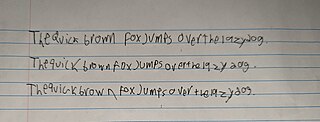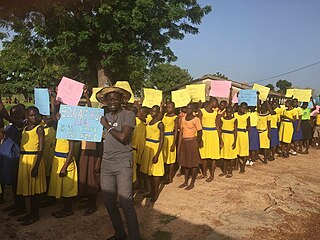Special education is the practice of educating students in a way that accommodates their individual differences, disabilities, and special needs. This involves the individually planned and systematically monitored arrangement of teaching procedures, adapted equipment and materials, and accessible settings. These interventions are designed to help individuals with special needs achieve a higher level of personal self-sufficiency and success in school and in their community, which may not be available if the student were only given access to a typical classroom education.
Mental disability may refer to:
An aptitude is a component of a competence to do a certain kind of work at a certain level. Outstanding aptitude can be considered "talent". Aptitude is inborn potential to perform certain kinds of activities, whether physical or mental, and whether developed or undeveloped. Aptitude is often contrasted with skills and abilities, which are developed through learning. The mass term ability refers to components of competence acquired through a combination of both aptitude and skills.
In criminal law, criminal negligence is an offence that involves a breach of an objective standard of behaviour expected of a defendant. It may be contrasted with strictly liable offences, which do not consider states of mind in determining criminal liability, or offenses that requires mens rea, a mental state of guilt.

Dysgraphia is a neurological disorder and learning disability that concerns written expression, which affects the ability to write, primarily handwriting, but also coherence. It is a specific learning disability (SLD) as well as a transcription disability, meaning that it is a writing disorder associated with impaired handwriting, orthographic coding and finger sequencing. It often overlaps with other learning disabilities and neurodevelopmental disorders such as speech impairment, attention deficit hyperactivity disorder (ADHD) or developmental coordination disorder (DCD).
An ability is the power an agent has to perform various actions.
Reading for special needs has become an area of interest as the understanding of reading has improved. Teaching children with special needs how to read was not historically pursued due to perspectives of a Reading Readiness model. This model assumes that a reader must learn to read in a hierarchical manner such that one skill must be mastered before learning the next skill. This approach often led to teaching sub-skills of reading in a decontextualized manner. This style of teaching made it difficult for children to master these early skills, and as a result, did not advance to more advanced literacy instruction and often continued to receive age-inappropriate instruction.
Phonological awareness is an individual's awareness of the phonological structure, or sound structure, of words. Phonological awareness is an important and reliable predictor of later reading ability and has, therefore, been the focus of much research.
Reading comprehension is the ability to process written text, understand its meaning, and to integrate with what the reader already knows. Reading comprehension relies on two abilities that are connected to each other: word reading and language comprehension. Comprehension specifically is a "creative, multifaceted process" dependent upon four language skills: phonology, syntax, semantics, and pragmatics.
A reading disability is a condition in which a person displays difficulty reading. Examples of reading disabilities include: developmental dyslexia, alexia, and hyperlexia.
A generalist is a person with a wide array of knowledge on a variety of subjects, useful or not. It may also refer to:

Mainstreaming, in the context of education, is the practice of placing students with special education needs in a general education classroom during specific time periods based on their skills. This means students who are a part of the special education classroom will join the regular education classroom at certain times which are fitting for the special education student. These students may attend art or physical education in the regular education classrooms. Sometimes these students will attend math and science in a separate classroom, but attend English in a general education classroom. Schools that practice mainstreaming believe that students with special needs who cannot function in a general education classroom to a certain extent belong in the special education environment.

Inclusion in education refers to all students being able to access and gain equal opportunities to education and learning. It arose in the context of special education with an individualized education program or 504 plan, and is built on the notion that it is more effective for students with special needs to have the said mixed experience for them to be more successful in social interactions leading to further success in life. The philosophy behind the implementation of the inclusion model does not prioritize, but still provides for the utilization of special classrooms and special schools for the education of students with disabilities. Inclusive education models are brought into force by educational administrators with the intention of moving away from seclusion models of special education to the fullest extent practical, the idea being that it is to the social benefit of general education students and special education students alike, with the more able students serving as peer models and those less able serving as motivation for general education students to learn empathy.
Emotional and behavioral disorders refer to a disability classification used in educational settings that allows educational institutions to provide special education and related services to students who have displayed poor social and/or academic progress.

Learning disability, learning disorder, or learning difficulty is a condition in the brain that causes difficulties comprehending or processing information and can be caused by several different factors. Given the "difficulty learning in a typical manner", this does not exclude the ability to learn in a different manner. Therefore, some people can be more accurately described as having a "learning difference", thus avoiding any misconception of being disabled with a possible lack of an ability to learn and possible negative stereotyping. In the United Kingdom, the term "learning disability" generally refers to an intellectual disability, while conditions such as dyslexia and dyspraxia are usually referred to as "learning difficulties".

Intellectual disability (ID), also known as general learning disability in the United Kingdom and formerly mental retardation, is a generalized neurodevelopmental disorder characterized by significantly impaired intellectual and adaptive functioning. It is defined by an IQ under 70, in addition to deficits in two or more adaptive behaviors that affect everyday, general living. Intellectual functions are defined under DSM-V as reasoning, problem‑solving, planning, abstract thinking, judgment, academic learning, and learning from instruction and experience, and practical understanding confirmed by both clinical assessment and standardized tests. Adaptive behavior is defined in terms of conceptual, social, and practical skills involving tasks performed by people in their everyday lives.
The term twice exceptional, often abbreviated as 2e, entered educators' lexicons in the mid-1990s and refers to gifted students who have some form of learning or developmental disability. These students are considered exceptional both because of their giftedness and because they are disabled or neurodivergent. Ronksley-Pavia (2015) presents a conceptual model of the co-occurrence of disability and giftedness.
There are a variety of disabilities affecting cognitive ability. This is a broad concept encompassing various intellectual or cognitive deficits, including intellectual disability, deficits too mild to properly qualify as intellectual disability, various specific conditions, and problems acquired later in life through acquired brain injuries or neurodegenerative diseases like dementia.

The Picture Exchange Communication System (PECS) is an augmentative and alternative communication system developed and produced by Pyramid Educational Consultants, Inc. PECS was developed in 1985 at the Delaware Autism Program by Andy Bondy, PhD, and Lori Frost, MS, CCC-SLP. The developers of PECS noticed that traditional communication techniques, including speech imitation, sign language, and picture point systems, relied on the teacher to initiate social interactions and none focused on teaching students to initiate interactions. Based on these observations, Bondy and Frost created a functional means of communication for individuals with a variety of communication challenges. Although PECS was originally developed for young children with autism spectrum disorder (ASD), its use has become much more widespread. Through the years, PECS has been successfully implemented with individuals with varying diagnoses across the aged span. PECS is an evidence-based practice that has been highly successful with regard to the development of functional communication skills.
Inclusive Classroom is a term used within American pedagogy to describe a classroom in which all students, irrespective of their abilities or skills, are welcomed holistically. It is built on the notion that being in a non-segregated classroom will better prepare special-needs students for later life. In the United States, the Rehabilitation Act of 1973 guaranteed civil rights to disabled people, though inclusion of disabled students progressed slowly until the No Child Left Behind Act of 2001, after which almost half of US students with disabilities were soon in general classrooms.





